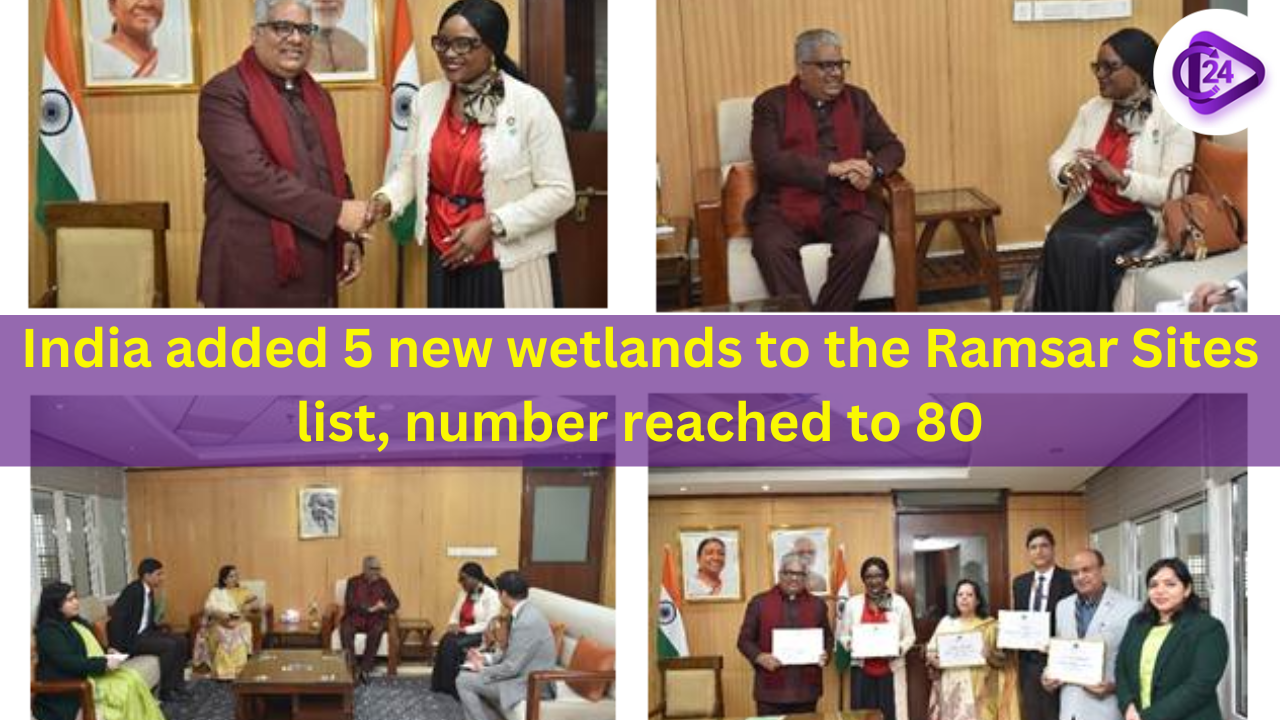India added 5 new wetlands to the Ramsar Sites list, number reached to 80

The Union Minister for Environment, Forest and Climate Change and Labour and Employment Bhupender Yadav has announced that the number tally of India's Ramsar sites (Wetlands of International Importance) has reached 80. Recently the Indian government has added 5 wetlands. This article is brief about the newly added five Indian Ramsar Sites.
What are Ramsar sites?
-
It is a wetland of international importance under the Ramsar Convention.
-
It is also known as the ‘Convention on Wetlands’.
-
It is an intergovernmental environmental treaty established by UNESCO in 1971.
-
Ramsar is a city in Iran, where the convention was signed that year.
Significance of Ramsar Sites:
-
The Ramsar tag helps the nation develop and maintain an international network of wetlands.
-
Thes wetlands are important for the conservation of global biological diversity.
-
It is also useful for sustaining human life through the maintenance of their ecosystem components, processes and benefits.
Ramsar Sites: India membership
-
India signed in Ramsar, Iran, in 1971 and became one of the Contracting Parties to the Ramsar Convention,
-
World Wetlands Day (WWD) is celebrated across the world on February 2, to commemorate the adoption of this international agreement on wetlands on 2nd February 1971.
-
India ratified this Convention on 1st February 1982.
India's Ramsar Sites: Newly added 5 Indian wetlands
-
Dr Musonda Mumba, Secretary General of the Convention on Wetlands, handed over the Ramsar Site certificates for:
-
Karaivetti Bird Sanctuary, Tamil Nadu
-
Magadi Kere Conservation Reserve, Karnataka
-
Longwood Shola Reserve Forest, Tamil Nadu
-
Ankasamudra Bird Conservation Reserve, Karnataka
-
Aghanashini Estuary, Karnataka
-
List of newly designated Ramsar Sites
|
Sl. No. |
Name of Ramsar Site |
State |
Total area in ha |
|
1 |
Ankasamudra Bird Conservation Reserve |
Karnataka |
98.76 |
|
2 |
Aghanashini Estuary |
Karnataka |
4801 |
|
3 |
Magadi Kere Conservation Reserve |
Karnataka |
54.38 |
|
4 |
Karaivetti Bird sanctuary |
Tamil Nadu |
453.72 |
|
5 |
Longwood Shola Reserve Forest |
Tamil Nadu |
116.007 |
|
5,523.867 |
India's Ramsar Sites: Number
After adding these 5 new wetlands, the existing number of India's Ramsar Sites reached to 80.
India's Ramsar sites: Key Highlights
-
Out of five, three sites i.e. Ankasamudra Bird Conservation Reserve, Aghanashini Estuary, and Magadi Kere Conservation Reserve are located in Karnataka.
-
The remaining wetlands sites i.e. Karaivetti Bird Sanctuary and Longwood Shola Reserve Forest are in Tamilnadu.
-
After adding these five wetlands to List of Wetlands of International Importance, the total area covered under Ramsar sites is now 1.33 million ha, an increase of 5,523.87 ha from the existing area of 1.327 million ha.
-
Tamil Nadu continues to have a maximum number of Ramsar Sites (16 sites) followed by Uttar Pradesh (10 sites).
Details about the Newly added 5 wetlands of India
Ankasamudra Bird Conservation Reserve:
-
It is a humanmade Village Irrigation Tank.
-
It was built centuries back and is spread over an area of 98.76ha (244.04 acre).
-
This reserve adjoining Ankasamudra village, Karnataka.
-
It is an ecologically important wetland, rich in biodiversity, comprising over 210 species of plants, 8 species of mammals, 25 species of reptiles, 240 species of birds, 41 species of fishes, 3 species of frogs, 27 species of butterflies and 32 species of odonates.
-
Over 30’000 waterbirds nest and roost at this wetland, which also supports more than 1% of the biogeographic population of Painted Stork (Mycteria leucocephala) and Black-headed Ibis (Threskiornis melanocephalus).
Aghanashini Estuary:
-
It is spread over an area of 4801 ha, is formed at the confluence of Aghanashini River with the Arabian sea.
-
The brackish water of the Estuary provides diverse ecosystem services including flood and erosion risk mitigation, biodiversity conservation and livelihood support.
-
Additionally, the mangroves bordering the estuary help to protect the shores against storms and cyclones.
-
The estuary regularly supports over 43,000 counts of over 66 waterbird species and over 1% of the biogeographic population of 15 waterbird species (which includes river tern, oriental darter, lesser black-backed gull, woolly- necked stork, Eurasian oystercatcher and others).
Magadi Kere Conservation Reserve
-
It is a human-made wetland with an area of nearly 50 hectares which was constructed to store rainwater for irrigation purposes.
-
It is home to over 166 species of birds, of which 130 are migratory.
-
The wetland harbours two vulnerable species, namely Common pochard (Aythya ferina) and River tern (Sterna aurantia) and four near-threatened species, namely Oriental Darter (Anhinga melanogaster), Black-headed Ibis (Threskiornis melanocephalus), Woolly- necked Stork (Ciconia episcopus) and Painted Stork (Mycteria leucocephala).
Karaivetti Bird Sanctuary:
-
It is spanning 453.72 ha is one of the largest inland wetlands of Tamil Nadu.
-
It is a significant source of groundwater recharge for the area.
-
Water from the wetland is utilized by the villagers for cultivating agricultural crops such as paddy, sugar cane, cotton, corn, and split red gram.
-
Karaivetti has one of the largest congregations of waterbirds in the State of Tamil Nadu.
The Longwood Shola Reserve Forest:
-
It derives its name from the Tamil word, "Solai", which means a ‘tropical rain forest’.
-
The ‘Sholas’ are found in the upper reaches of the Nilgiris, Anamalais, Palni hills, Kalakadu, Mundanthurai and Kanyakumari in Tamil Nadu.
-
These forested wetlands serve as habitats for the globally endangered Black-chinned Nilgiri Laughing thrush (Strophocincla cachinnans), Nilgiri Blue Robin (Myiomela major), and vulnerable Nilgiri Wood-pigeon (Columba Elphinstone).
FAQs
1. World Wetlands Day is observed annually on which date?
Ans: World Wetlands Day is observed annually on February 2.
2. What is the theme of World Wetlands Day 2024?
Ans: The theme of World Wetlands Day 2024 is Wetlands and Human Wellbeing
3. What is the total number of India's Ramsar site, as of February 2024?
Ans: The Union Minister for Environment, Forest and Climate Change and Labour and Employment Bhupender Yadav has announced that the number tally of India's Ramsar sites (Wetlands of International Importance) has reached 80.




